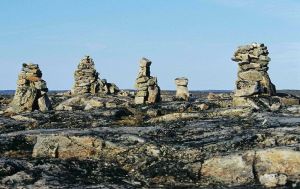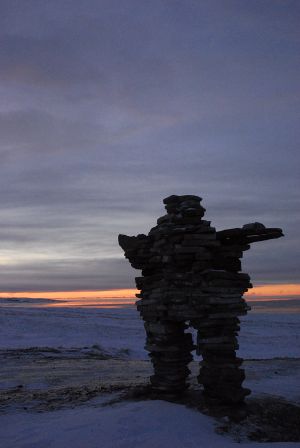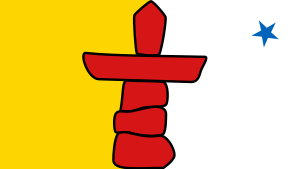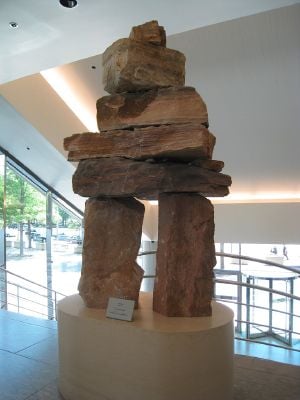Inuksuk
An inuksuk (plural inuksuit) (from the Inuktitut: ᐃᓄᒃᓱᒃ, plural ᐃᓄᒃᓱᐃᑦ; alternatively inukshuk in English or inukhuk in Inuinnaqtun is a stone landmark or cairn built by humans, used by the Inuit, Inupiat, Kalaallit, Yupik, and other peoples of the Arctic region of North America. These structures are found from Alaska to Greenland, a region above the Arctic Circle that is dominated by the tundra biome and has areas with few natural landmarks.
| This article contains Canadian Aboriginal syllabic characters. Without proper rendering support, you may see question marks, boxes, or other symbols instead of syllabics. |
Name
The word inuksuk means "something which acts for or performs the function of a person." The word comes from the morphemes inuk ("person") and -suk ("ersatz" or "substitute") in the Inuit language, Inuktitut. The plural is inuksuit.[1]
The word is pronounced inutsuk in Nunavik and the southern part of Baffin Island. In many of the central Nunavut dialects, it has the etymologically related name inuksugaq (plural: inuksugait).
It is often alternatively written inukshuk in English or inukhuk in Inuinnaqtun[2] However, the Governments of Nanavut and Canada support the Inuit-preferred spelling inuksuk.
A structure similar to an inuksuk, but meant to represent a human figure, is called an inunnguaq (ᐃᓄᙳᐊᖅ, "imitation of a person," plural inunnguat), has become widely familiar to non-Inuit. However, it is not the most common type of inuksuk, and it is distinguished from inuksuit.[3]
Description
Inuksuit are markers, beacons, or cairns built of dry stacked stones, driftwood or bones. They range in size from .5 meters (1.6 ft) 2 meters (6.6 ft) in height and up to 2 meters (6.6 ft) in width.[4] Norman Hallendy, who spent 40 years in the Arctic among the Inuit, has described a total of 24 types and arrangements of inuksuit, which he categorized into three sets.[5]
They appear throughout the Arctic, with several prominent forms along the shores and in the interior between Hudson Bay and Ungava Bay in Nunavik. Most hilltops near Inuit villages feature an inuksuk.[4] There are unusual concentrations of between 100-200 inuksuit at Inuksualait (Enukso Point), on Baffin Island. The site was designated a National Historic Site of Canada in 1969.[6]
Historical usage

Varying in shape and size, the inuksuit have longtime roots and served an important role in the Inuit culture for thousands of years. Many conveyed messages, while others were used as aids in hunting. Still others had a spiritual meaning.
An inuksuk could be used for navigation, as a point of reference, a marker for travel routes, fishing places, camps, hunting grounds, places of veneration, drift fences used in hunting,[7] or to mark a food cache.[8] The Inupiat in northern Alaska used inuksuit to assist in the herding of caribou into contained areas for slaughter. Hunters could also hide behind a larger inuksuk.[8]
Modern usage
Inuksuit continue to serve as an Inuit cultural symbol. For example, an inuksuk is shown on the flag and coat of arms of the Canadian territory of Nunavut, and the flag of Nunatsiavut. The high school in Iqaluit is named Inuksuk High School after the landmarks.
InuksuitTemplate:Emdashparticularly, but not exclusively, of the inunnguaq varietyTemplate:Emdashare also increasingly serving as a mainstream Canadian national symbol. In 1999 Inukshuk was the name for the International Arctic Art & Music Project of ARBOS in the Canadian provinces of Québec, Ontario, Nunavik, and Nunavut; and in Greenland, Austria, Denmark and Norway.[9]
On July 13, 2005, Canadian military personnel erected an inuksuk on Hans Island, along with a plaque and a Canadian flag, as part of Canada's longstanding dispute with Denmark over the small Arctic island.[10] The markers have been erected throughout the country, including a nine-metre-high inuksuk that stands in Toronto on the shores of Lake Ontario. Located in Battery Park, it commemorates the World Youth Day 2002 festival that was held in the city in July 2002.
Artisan Alvin Kanak of Rankin Inlet, Northwest Territories (now in the territory of Nunavut), created an inuksuk as a gift to the city for Expo 86. The land has since been donated to the city, and is now a protected site.
An inunnguaq is the basis of the logo of the 2010 Winter Olympics designed by Vancouver artist Elena Rivera MacGregor. Its use in this context has been controversial, both among the Inuit and the First Nations of British Columbia. Although the design has been questioned, people believe it pays tribute to the inuksuk that stands at Vancouver's English Bay. Friendship and the welcoming of the world are the meanings of both the English Bay structure and the 2010 Winter Olympics emblem.[citation needed]
The Vancouver 2010 logo and the construction of inuksuit around the world have led to increasing recognition of them.[citation needed] There are five authentic inuksuit which were donatedTemplate:Emdashwholly or in partTemplate:Emdashby the government of Canada: in Brisbane, Australia; Monterrey, Mexico; Oslo, Norway; Washington D.C., United States; and Guatemala City.[11]
The most recent Canadian-donated inuksuk was built in Monterrey in October 2007 by the Inuvialuit artist Bill Nasogaluak. The sculpture was presented to the people of the northern state of Nuevo León as a gift from the Monterrey chapter of the Canadian Chamber of Commerce in Mexico and the Government of Canada, to mark the chamber’s 10th anniversary in the city. The sculpture stands over the Santa Lucía Riverwalk. Nasogaluak, of Tuktoyaktuk, personally chose the rocks for the structure from a local quarry near Monterrey. The inuksuk contains two rocks which the artist took to Mexico from Canada, one from the high Arctic and another from his home town of Toronto. Together they form the inuksuk’s heart.
The inuksuk was also used as the symbol of the Summit of the Americas, because of its connotations of "guidance and unity...towards common goals."[12]
Officials in various wilderness parks throughout Canada routinely dismantle inuksuit constructed by hikers and campers, for fear that they could misdirect park visitors from the cairns and other markers that indicate hiking trails. The practice of erecting inuksuit in parks has become so widespread that Killarney Provincial Park, on the north shore of Ontario's Georgian Bay, issued a notice in 2007 urging visitors to "stop the invasion" of inuksuit.[13]
A large number of inuksuit have been built in some areas along the Trans-Canada Highway, including Northern Ontario. In 2010, a journalist from Sudbury's Northern Life counted 93 inuksuit along Highway 69 between Sudbury and Parry Sound. The journalist successfully tracked down a person who had built two inuksuit along the route; he attributed his action to having had a "fill the dreams moment where I needed to stop and do it" while driving home from a family funeral.[14]
According to Guinness World Records, the tallest inuksuk is in Schomberg, Ontario, Canada. Built in 2007, it is 11.377m tall.[15]
Notes
- ↑ Alex Spalding, Inuktitut: A Multi-dialectal Outline Dictionary (Nunavut Arctic College, 1998, ISBN 978-1896204291).
- ↑ Gwen Angulalik (ed.), Inuinnaqtun-English Dictionary (Inhabit Media, 2012).
- ↑ Peter Irniq, [http://www.tunngavik.com/documents/publications/2006-Naniiliqpita-Spring.pdf The Ancestral Inuksuk Ingilgaat Inuksuit] Naniiliqpita, Nunavut Tunngavik Inc., 2006. Retrieved September 30, 2013.
- ↑ 4.0 4.1 Scott Heyes, Protecting the authenticity and integrity of inuksuit within the arctic milieu Études/Inuit/Studies 26(2) (2002):133-156. Retrieved September 30, 2013.
- ↑ Norman Hallendy, Inuksuit: Silent Messengers of the Arctic (Douglas and McIntyre, 2001, ISBN 978-1550548747).
- ↑ Inuksuk National Historic Site of Canada Canada's Historic Places. Retrieved September 30, 2013.
- ↑ Charlotte Gray, The Museum Called Canada, 25 Rooms of Wonder (Random House of Canada, 2004, ISBN 978-0679312208).
- ↑ 8.0 8.1 The Inuit Inukshuk Simon Fraser University Office for Aboriginal Peoples. Retrieved September 30, 2013.
- ↑ Inukshuk - The Arctic Art & Music Project of ARBOS, edition selene, Vienna 1999. ISBN 3-85266-126-9
- ↑ Press release from the Government of Canada, Foreign Affairs and International Trade. Google cache copy.
- ↑ Green, Sarah. "Inuit art finds home in Mexico", Toronto Sun, 2 Nov 2007, Retrieved 2007-11-08.
- ↑ Proceedings of the XLVI Meeting of the Summit Implementation Review Group (SIRG)
- ↑ Of ego and inukshuks, Globe and Mail. August 17, 2007. Retrieved 2007-08-19.
- ↑ "The Inukshukification of Highway 69". Northern Life, September 22, 2010.
- ↑ Tallest Inukshuk. Guinness World Records. Retrieved 1 January 2013.
ReferencesISBN links support NWE through referral fees
- Angulalik, Gwen (ed.). Inuinnaqtun-English Dictionary. Inhabit Media, 2012. ASIN B00DZG5PI8
- Gray, Charlotte. The Museum Called Canada: 25 Rooms of Wonder. Random House of Canada, 2004. ISBN 978-0679312208
- Hallendy, Norman. Inuksuit: Silent Messengers of the Arctic. Douglas & McIntyre, 2001. ISBN 978-1550548747
- Hallendy, Norman. Tukiliit: The Stone People Who Live in the Wind. University of Alaska Press, 2009. ISBN 978-1602230576
- Niosi, Goody. Ken Kirkby: A Painter's Quest for Canada. Libros Libertad, 2009. ISBN 978-0981073576
- Spalding, Alex. Inuktitut: A Multi-dialectal Outline Dictionary. Nunavut Arctic College, 1998, ISBN 978-1896204291
External links
All links retrieved
- Arctic Inuit Art
- Inuksuk, Inunnguaq, Inuksuit
- Inukshuk The Canadian Encyclopedia
- Places of Power - essay and photographs of inuksuit
- Vancouver 2010 Olympic Winter Games Emblem
- Canadian Heritage Minute video about the inuksuk
Credits
New World Encyclopedia writers and editors rewrote and completed the Wikipedia article in accordance with New World Encyclopedia standards. This article abides by terms of the Creative Commons CC-by-sa 3.0 License (CC-by-sa), which may be used and disseminated with proper attribution. Credit is due under the terms of this license that can reference both the New World Encyclopedia contributors and the selfless volunteer contributors of the Wikimedia Foundation. To cite this article click here for a list of acceptable citing formats.The history of earlier contributions by wikipedians is accessible to researchers here:
The history of this article since it was imported to New World Encyclopedia:
Note: Some restrictions may apply to use of individual images which are separately licensed.






